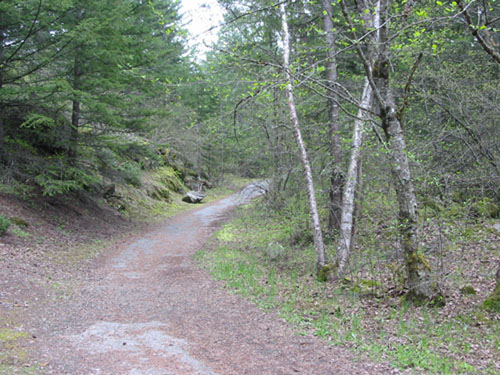Other Name(s)
n/a
Links and documents
Construction Date(s)
1926/01/01
Listed on the Canadian Register:
2011/02/22
 Statement of Significance
Statement of Significance
Description of Historic Place
Alexandra Bridge is a steel and concrete suspension bridge spanning the Fraser River adjacent to Alexandra Bridge Provincial Park, 22 kilometres north of Yale in southwestern British Columbia. The historic place includes the 1926 bridge, its associated roadwork and retaining walls, and the abutments and footings remaining from the original bridge built in 1863. The bridge is situated adjacent to surviving remnants of historic fur brigade trails and early roads which are currently used as public walking trails.
Heritage Value
The Alexandra Bridge is significant for the historical, scientific, cultural, aesthetic and recreational values of the structure and its location within the surrounding Fraser Canyon landscape.
The current steel and concrete suspension bridge is the second bridge located at this site, and is valued as a symbol of the evolution and continued use of this location as a key crossing point of the Fraser River. The bridge is associated with the development of a more direct Fraser Canyon route to the gold fields near Quesnel, necessitated by the influx of Fraser River and Cariboo gold seekers in the late 1850s. As a result, the province was opened up to settlement and development, linking the Alexandra Bridge with the important regional historical themes of transportation, settlement and resource extraction.
The location of the bridge at a narrow point in the Fraser Canyon is important because it is associated with ongoing First Nations fishing traditions. The bridge is located at a place where the river is forced through the narrow, steep banks, offering fishermen an opportunity to harvest salmon passing through the narrowed gorge.
The Alexandra Bridge represents one of the Fraser Canyon's most important engineering feats, in which suspension bridge technology was used to overcome the difficult topography. It represents 100 years of contemporary bridge engineering in the Canyon.
As a natural stop-over and crossing point on the Fraser River since the Fraser Canyon was first populated, the Alexandra Bridge is valued as a place that represents the transportation history of this area. It is an historical and natural link to the coastal and interior regions of the province. The association of the first bridge (1863) with early Hudson's Bay Company trails in the 1850s, the superseding of the route by the arrival of the Canadian Pacific and Canadian National railways in 1881, and the construction of the 1926 bridge and associated highway are all reflections of the importance of transportation at this site. It is notable that the nearby Alexandra Lodge, an important roadhouse on the Cariboo Road, is also associated with this site and its transportation history. The existing (1926) Alexandra Bridge is valued as a reminder of the growth of automobile travel in the region in the 1920s and for its key role in the evolution of the Fraser Canyon into an important tourist destination.
The bridge is further valued for its association with early historical figures important in British Columbia's history, including original bridge builder Joseph Trutch, Princess Alexandra, for whom the bridge was named, and Hudson's Bay Company fur trader Alexander C. Anderson. The bridge is also valued for its nicknames: "Black Canyon" and "Big Canyon."
The bridge, in its surrounding landscape including the dramatic cliffs and swirling water of the Fraser River, is important as a regional landmark, providing views up and down the Canyon. The bridge has important recreational value as part of a scenic walking trail based on early trails and roadways.
Source: Ministry of Environment, BC Parks
Character-Defining Elements
Key character-defining elements of Alexandra Bridge include its:
Site:
-dramatic location near an historic gold rush site (Chapman's Bar) and roadhouse (Alexandra Lodge)
-situation at a narrows in the Fraser Canyon
-concrete retaining walls associated with grade manipulation
-views to and from the bridge
-proximity to recreational trail (1926 highway) and remnants of Hudson's Bay Company brigade trail
Structure:
-bridge structure (1863 abutments, 1926 deck)
-arched concrete bridge towers
-concrete abutments
-steel bridge deck, wrapped wire cables and metal railing
-name: "Alexandra Bridge"
 Recognition
Recognition
Jurisdiction
British Columbia
Recognition Authority
Province of British Columbia
Recognition Statute
Heritage Conservation Act, s.9, s.13(1)(a)
Recognition Type
Provincial Heritage Site (Designated)
Recognition Date
1974/03/13
 Historical Information
Historical Information
Significant Date(s)
1863/01/01 to 1863/01/01
Theme - Category and Type
- Developing Economies
- Trade and Commerce
- Developing Economies
- Technology and Engineering
- Developing Economies
- Communications and Transportation
- Peopling the Land
- Settlement
Function - Category and Type
Current
- Transport-Land
- Pedestrian Way
Historic
- Transport-Land
- Bridge, Tunnel or Other Engineering Work
Architect / Designer
n/a
Builder
Joseph W. Trutch
 Additional Information
Additional Information
Location of Supporting Documentation
Ministry of Environment, BC Parks
Cross-Reference to Collection
Fed/Prov/Terr Identifier
DkRi-12
Status
Published
Related Places

Royal Engineers' Road at Alexandra Bridge
The Royal Engineers' Road exists as portions of a hiking trail that leads down a switchback trail and across the Canadian National Railway tracks to the site of the 1926 Alexandra…